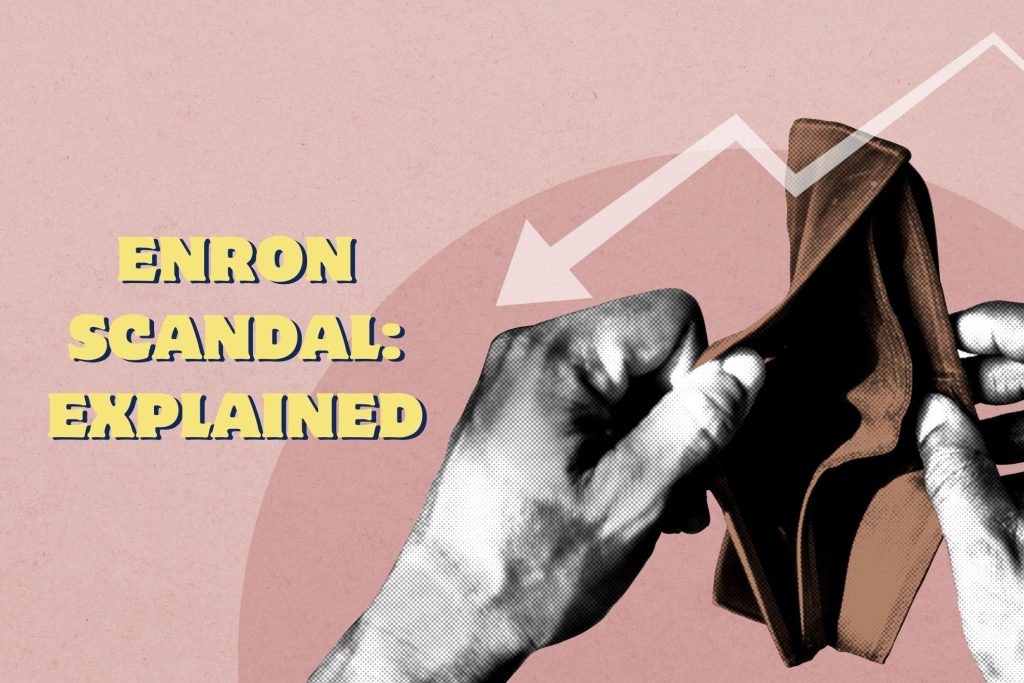
Imagine – It’s the dawn of the 21st century. The economy is booming, dot-coms are soaring high, and among them, a particular star shines the brightest – Enron. An energy company that at its peak carried a worth of about $70 billion. But within a span of few years, this magnificent empire crumbled into nothing, drowning in a sea of fraud and deceit.
“The Enron scandal drew attention to accounting and corporate fraud, as its shareholders lost $74 billion in the four years leading up to its bankruptcy, and its employees lost billions in pension benefits.”
What truly unfolded in this financially catastrophic event known as the Enron Scandal? You’re about to uncover this riveting and educational journey into the depths of corporate fraud.
History of Enron
Let’s journey back to the origins of Enron Corporation. Enron was an American energy company based in Houston, Texas. Founded in 1985, Enron was the result of a merger between two gas companies, Houston Natural Gas and InterNorth.
Under the helm of its charismatic leader, Kenneth Lay, Enron swiftly diversified into an array of industries, including power production, energy trading, and even broadband services. By the mid-90s, Enron was hailed as a new business model, an Internet-age powerhouse in touch with the ‘new economy’.
The company reached astounding heights; it was named “America’s Most Innovative Company” for six consecutive years by Fortune magazine. Enron’s successful facade, however, was just that.
However, a troublesome mixture of elaborate accounting schemes, opaque financial reports, and unethical corporate practices ripped this corporate titan apart. The company’s stock, once priced at $90 per share, plummeted to a pitiful end at $0.26. The Enron scandal, which erupted in 2001, is arguably one of the most notorious episodes of corporate fraud in American history.
See also: Why Accounting Matters for Your Startup
The Deception Behind the Success
Understanding the magnitude and severity of Enron’s deceit involves delving a little deeper.
Enron’s leadership, including CEO Jeffrey Skilling and CFO Andrew Fastow, artificially inflated the company’s profits and fooled investors through complicated and often illegal financial maneuvers.
At the heart of Enron’s downfall was its practice of ‘mark-to-market’ accounting. Essentially, Enron would seemingly pin the future worth of a project on present revenues on the day the deal was signed, regardless of true future cash flow. This technique allowed the illusion of projected earnings to be treated as real, instant profit.
Imagine selling a car, and the moment you have a signed contract, you record the full sales value on your books without having received a single penny. If the buyer backs out later, you’re in a fix.
Yet, using this method, Enron began to include projected earnings from long-term energy contracts in their accounts. Therefore, the company was able to claim future profits as part of their fiscal success, albeit these profits hadn’t been realized yet.
To add to the ruse, among these maneuvers was the use of special purpose entities (SPEs). These are firms formed for specific objectives, typically linked to securing or reorganizing debt. For Enron, it was a corporate structure that enabled them to hide debt and fake profitability.
They transferred liabilities and losses into these SPEs, making the company’s financial health appear far better than it was in reality. These SPEs, conveniently managed by Fastow himself, presented a distorted image of Enron’s financial health to the outside world – that Enron was more vibrant and financially stable than it actually was.
Now here’s the rub: The executives at Enron didn’t work alone. They had complicity from their auditing firm, Arthur Andersen. The firm not only overlooked Enron’s audit but also neglected their advisory role with respect to Enron’s accounts. This audacious breach of trust amplified the severity of the scandal and its subsequent impact. Being found guilty of obstruction of justice, Arthur Andersen eventually saw its dissolution.
A House of Cards
The duplicitous practices couldn’t last indefinitely. In 2001, skeptics started to question Enron’s financial health and accounting integrity. Strong hints of risk and fiscal irregularities began to fill the air, despite Enron’s continuous efforts to project positivity.
The Dark Reality
Behind the scenes, Enron’s true financial situation was critical. The company’s debt was astronomical, and their actual profits were nowhere near the figures presented in their public statements. This was a ticking time bomb destined to implode sooner or later.
The Whistleblowers
As such scandals tend to play out, a few keen executives and employees started noticing the irregularities. They were the ones to bring the issue into the limelight. Their role cannot be understated in the unfolding of the Enron saga. It was Sherron Watkins, a Vice President at Enron, who was among the first to blow the whistle on the company’s fraudulent accounting practices.
The Unraveling
By 2001, the company’s manipulations started to unravel when a series of off-balance-sheet SPEs led to investigations by the Securities and Exchange Commission (SEC). Beneath the external success, Enron was in reality, a house built on a precarious pile of debts. The curtain was finally raised when Enron declared bankruptcy in December 2001, revealing the organization’s $74 billion in hidden debt.
Once the scandal broke out, Enron’s stock price plummeted from almost $90 to less than $1, leading to one of the most notorious bankruptcies in corporate history. With millions of investors losing their money, the fall of Enron was a catastrophic event that echoed across the global financial markets.
This announcement shocked not only the business world but also the 20,000 employees who lost both their jobs and their pensions.
The Aftermath
Fastow was sentenced to six years in prison, while Skilling received a 24-year sentence. The Enron scandal highlighted the need for increased regulation and oversight in financial reporting, eventually leading to the implementation of the Sarbanes-Oxley Act of 2002.
The Role of Wall Street
Perhaps one of the most blatant red flags ignored was the consistent support and lauding from Wall Street and financial analysts. The stock prices of Enron defied gravity, soaring even while company’s practices were raising many questions among some insiders and industry experts.
The Wall Street’s insatiable appetite for high-performance stocks and the prevalent culture of fierce competition often breeds complacency for ethical standards. In the case of Enron, it’s clear that Wall Street chose wilful blindness over regulatory responsibility.
This bias and conflict of interest in Wall Street firms, having invested in these companies themselves, acted as catalyzing factors in the Enron debacle. The reluctance to conduct due diligence and question the overtly positive financial results further fostered Enron’s culture of deception, leading to one of the biggest corporate scandals in history.
What Can We Learn From It?
Perhaps the greatest takeaway from the Enron scandal is the importance of transparency and ethics in business. The scandal clearly illustrates how destructive and devastating unethical practices can be, not only to a business but also to society as a whole.
Thus, it serves as a cautionary tale for other corporations, urging them to maintain transparency in their dealings, show integrity in their actions, and uphold the rule of law.
After all, losing the trust of stakeholders is a price no business can afford to pay.
Furthermore, being honest and open can build business reputation, foster customer loyalty, and ensure long-term sustainability. Not to mention, ethical business practices contribute positively to the overall economy by promoting fair competition and societal welfare.
It’s compelling to pore over the specifics of the Enron saga, but it’s equally crucial to remember the human consequence. Thousands of people lost their jobs, and investors lost billions. Thus, Enron serves as a stark reminder of the far-reaching effects of corporate greed and deception.
While you may think you’re immune to a scandal like Enron’s, it’s always best to remember the lessons it imparts. Not only about ethical business practices but also about the true danger of too much unchecked power and dishonesty in the corporate world.
So, as we conclude our exploration of the Enron scandal, let’s take its lessons to heart and strive to foster a more ethical and transparent corporate world. Remember, it’s not just about the bottom line – it’s also about the way we reach it.



